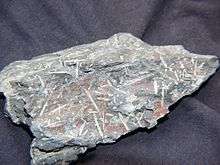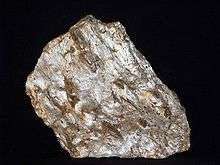Knotenschiefer


Knotenschiefer is a variety of spotted slate characterized by conspicuous subspherical or polyhedral clots that are often individual minerals such as cordierite, biotite, chlorite, andalusite and others.[1]
Like fleckschiefer, fruchtschiefer and garbenschiefer, knotenschiefer is a variety of contact metamorphic slate. It is formed at temperatures of around 400 °C and its dark coloration is caused by graphite. Fruchtschiefer occurs at 500 °C. Knotenschiefer is characterised by small nodules, up to one centimetre in size, and nodular deposits of mica as a result of the growth in grain size during metamorphism. The nodules consist of iron minerals, carbon substances and mica; as the metamorphic temperature rises, minerals such as andalusite or chiastolite increasingly occur.
References
- ↑ Bucksch, Herbert (1997). Dictionary of Geotechnical Engineering, Vol. 2., Springer-Verlag, Berlin. ISBN 3-540-58163-4.
- Walter Maresch, Olaf Medenbach: Steinbachs Naturführer. Gesteine. S. 252. Mosaik Verlag, München 1987, ISBN 3-576-10699-5.
- Fleckschiefer. Otto Lueger: Lexikon der gesamten Technik und ihrer Hilfswissenschaften. Bd. 4, Stuttgart, Leipzig 1906, S. 82.